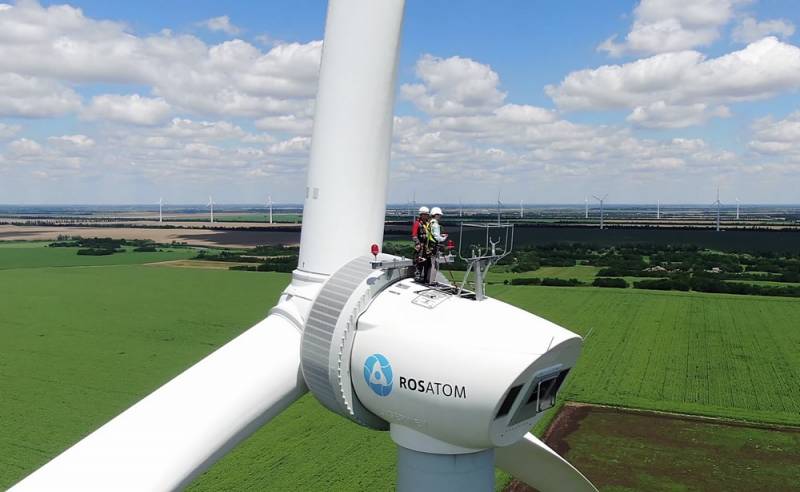We are ten times behind: what hinders the development of wind energy in Russia
One of the most well-studied and used in different countries of the world types of alternative energy is wind energy. Its percentage share in global electricity production in 2021 was 6,6%. The same indicator in Russia for the same year stopped at 0,32%, that is, 20 times less.
In the Russian Federation, the state and prospects of wind energy are largely determined by support from government authorities and market incentives. But, unlike European countries, as can be seen from the statistics presented above, the domestic industry lags behind both quantitatively and technologically.
Currently, about 35 wind farms operate in our country. In 2021, they managed to generate 3622 million kWh. The greatest prospects for wind energy in the Russian Federation exist in the steppe regions of the country (Kalmykia, Stavropol Territory, Crimea, Astrakhan and Rostov regions), in areas where the construction of additional nuclear power plants and hydroelectric power plants is simply impossible. It is in these subjects that the lion's share of domestic wind farms is located.
When discussing the future prospects for the development of this type of power plants in Russia, it is necessary to understand all the risk factors and disadvantages that are likely to be encountered when building new wind farms in the country. Among them are the following:
1) the development of the industry is strongly hampered by the already formed and quite efficiently functioning traditional energy complex. It is supported by large reserves of resources and lobbying of its interests by representatives of the business community. In this situation, even the potential opportunities for financial savings do not stimulate wind energy in Russia as much as it happens in the same European countries;
2) last year, as a result of sanctions, a ban was adopted on the export of components for wind turbines to the Russian Federation. Most of the technical solutions related to the conversion of wind energy, our companies received from leading Western companies. So at the moment, organizations that have assumed legal obligations for the construction of wind farms have found themselves in a rather difficult situation, all the processes for commissioning wind farms are hindered. In the near future, we should expect the transformation of logistics routes and the development of new markets for the purchase of products that fell under sanctions;
3) another important factor that does not allow interested players in the energy market to make significant investments in the industry is the high risks that companies may face when operating wind farms. The instability of such an energy source creates additional problems when using this direction on an industrial scale;
4) in our country, many have formed misconceptions about the capabilities of wind turbines. Often people consider wind energy as an “expensive toy” that is not capable of providing real economic results;
5) it is also necessary to pay attention to a certain backwardness of the power equipment used in wind farms in Russia. Domestic components are an order of magnitude inferior in quality to foreign counterparts, which makes this industry extremely dependent on imports.
Despite all the difficulties in the development of this type of energy, it is assumed that the total capacity of wind farms on the WECM in Russia can reach 23,3 GW by 2030. Such results would be enough to cover about 10% of the country's energy supply and create about 50 jobs to maintain the infrastructure of wind farms (according to WWEA). Such prospects indicate that this type of energy has certain advantages, which will be discussed below:
1) the operation of wind farms significantly reduces the environmental damage that traditional energy sources of equivalent capacity could cause to the environment;
2) Russia is a very large country, many settlements are located in hard-to-reach areas. It is rather problematic to transport electricity, often it is necessary to pull power lines for hundreds of kilometers in order to provide the inhabitants of remote villages and villages with the necessary resources. In this situation, the optimal solution is the construction of small wind farms that would generate electricity not on an industrial scale, but for the personal needs of the population;
3) the availability of construction. This is a conditional factor, but if we compare the implementation of such generators with the same traditional stations, then the savings will be significant. In addition, wind farms may not be classified as capital construction projects. The scale of work required for the commissioning of such facilities cannot be compared with the construction of the same hydroelectric power plants.
If an attempt is made to summarize the prospects for the development of wind farms in Russia, it is worth noting that wind farms in our country can demonstrate quite high capacity indicators and there are prerequisites for further increasing productivity and building new facilities of this type. However, at the moment, the share of wind energy in the overall energy system of the Russian Federation is extremely insignificant, despite all the statements from officials and representatives of the energy complex about the high importance and usefulness of alternative energy sources.
In addition, the development of the industry is hampered by a number of climatic and geographical restrictions that lead to higher costs and complexity of the use of wind energy in Russia, but at the same time, for some regions of our country, wind energy may become almost the only possible option for solving problems associated with a shortage electricity.

Information